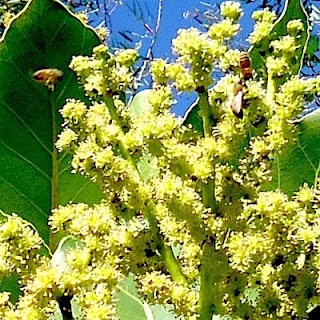Apocynaceae is a large tropical family that's not well-represented in New Zealand. In the native flora we have just
Parsonsia, so-called native jasmine, kaihua or akakaikiore. In the naturalised flora there's oleander (
Nerium oleander), periwinkle (
Vinca spp.), and—because the family Asclepiadaceae is now included in Apocynaceae—swan plant (
Gomphocarpus fruticosus) and a couple of others. Plants of the family accumulate some nasty toxins, some of which are useful as drugs.
Like a lot of vines,
Parsonsia leaves are very variable, sometimes with quite spectacularly different shapes occurring at adjacent nodes on a stem. The leaves of young plants can be elongated with sinuous margins, elongated with an expanded tip, broad and elliptical, or even lobed at the base (Allan 1961 has an illustration), but the adult leaves are more consistently ovate. Probably because of this variability, quite a few species have been described, but these were reduced to two by the time of Allan's Flora (Allan 1961),
P. heterophylla and
P. capsularis, to which
P. praeruptis, a distinctive scrambling shrub from Surville Cliffs, Northland, was added recently (Heads & de Lange 1999).
500px.jpg) |
| Parsonsia heterophylla at Tunnel Gully, Hutt Valley. |
The flowers are small, and resemble those of other Apocynaceae; they're like tiny frangipani flowers (
Plumeria) and they do smell sweet.
 |
| Parsonsia heterophylla at Birdwood Reserve, Karori, Wellington. |
Right now the fruits are ripening, although last year's empty ones are still on the vines. These are long pods, each with a kind of double structure, so that when they open there are four valves produced, two broad and two narrow.
 |
| Parsonsia heterophylla fruits, line scale is 10 mm. |
The seeds of
Parsonsia are quite large, and wind dispersed. Each has a coma (a botanical term for a tuft of hairs) that increases its surface area and allows it to float on the wind.
 |
| Parsonsia heterophylla seeds, line scale is 10 mm |
References
Allan, H.H. 1961.
Flora of New Zealand Vol 1. Government Printer, Wellington
Heads, M.J.; de Lange, P.J. 1999.
Parsonsia praeruptis (Apocynaceae): A new threatened, ultramafic endemic from North Cape, New Zealand.
New Zealand Journal of Botany 37: 1–6.
Sykes, W.R. 1988. Apocynaceae, in Webb, C.J.; Sykes, W.R.; Garnock-Jones, P.J.
Flora of New Zealand Vol. 4. DSIR, Christchurch.
.jpg)
.jpg)









500px.jpg)



4.jpg)




500px.jpg)

.jpg)






